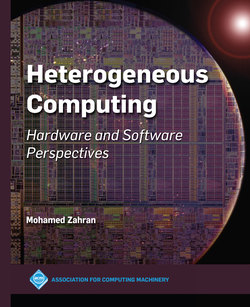Читать книгу Heterogeneous Computing - Mohamed Zahran - Страница 8
На сайте Литреса книга снята с продажи.
ОглавлениеPreface
The term heterogeneous computing has become famous lately (lately, meaning in the last five years!). It started infiltrating many articles. Research papers have been, and are still being, written about heterogeneous computing and its implications on both software and hardware. The definition of this term is quite straightfor-ward: executing programs on a computing platform with computing nodes of different characteristics. What is tricky is whether this is a good thing or a bad thing.
From a hardware perspective, as we will see later in this book, it is a good thing. Each computing node is efficient in specific types of applications. Efficiency here means it gets the best performance (e.g., speed) with lowest cost (e.g., power). This excellence in price-performance is very much needed in our current era of big data, severe power consumption, and the road to exascale computing. So if we can assign to each node the part of the program that it excels at, then we get the results of price-performance, and this is the main challenge facing the software community.
From a software perspective, heterogeneous computing seems like bad news because it makes programming much more challenging. As a developer, you have way more tasks than with traditional homogeneous computing. You need to know about different execution units, or at least learn about the computing nodes in the system you are writing code for. Then you need to pick algorithms to make your program, or different parts of your program, suitable for these nodes. Finally, you need to tweak your code to get the needed performance by overcoming many bottlenecks that certainly exist in heterogeneous computing, like communication overhead between the different units, overhead of creating threads or processes, management of memory access of those different units, and so on.
We cannot then say that heterogeneous computing is good or bad news. But we can say that heterogeneous computing is now the norm and not the exception. It is here, it will continue to be here, and we need to deal with it. But how do we deal with it? This is the topic of this book.
This book discusses the topic of heterogeneous computing from different angles: hardware challenges, current hardware state-of-the-art, software issues, how to make the best use of the current heterogeneous systems, and what lies ahead. All the systems we use, from portable devices to supercomputers, embody some type of heterogeneity. The main reason for that is to have good performance with power efficiency. However, this opens the door to many challenges that we need to deal with at all levels of the computing stack: from algorithms all the way to process technology. The aim of this book is to introduce heterogeneous computing in the big picture. Whether you are a hardware designer or a software developer, you need to know how the pieces of the puzzle fit together.
This book will discuss several architecture designs of heterogeneous system, the role of operating system, and the need for more efficient programming models. The main goal is to bring researchers and engineers to the forefront of the research frontier in the new era that started a few years ago and is expected to continue for decades.
Acknowledgments
First and foremost, I would like to thank all my family for their support, encouragement, and unconditional love. I would like to thank Steve Welch, who is actually the one who gave me the idea of writing this book. A big thank you goes also to Tamer Özsu the editor-n-chief of ACM books, for his encouragement, flexibility, and willingness to answer many questions. Without him, this book wouldn’t have seen the light of day.
Anything I have learned in my scientific endeavors is due to my professors, my students, and my colleagues. I cannot thank them enough. Dear students, we learn from you as much as you learn from us.
Mohamed Zahran
September 2018
